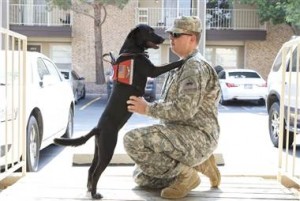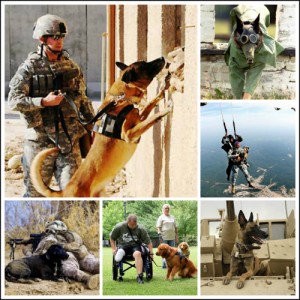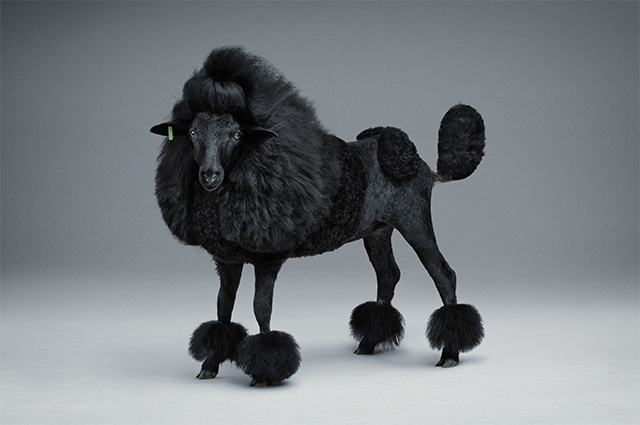Working Dogs
Category
PTSD in Military Working Dogs
 In my new release, MEN UNDER FIRE, Sgt. Nick Welby isn’t the only veteran returning home from Afghanistan with PTSD. His partner Talley, a bomb-sniffing canine, is also struggling to overcome Post-traumatic Stress Disorder.
In my new release, MEN UNDER FIRE, Sgt. Nick Welby isn’t the only veteran returning home from Afghanistan with PTSD. His partner Talley, a bomb-sniffing canine, is also struggling to overcome Post-traumatic Stress Disorder.
Nick and Talley are strong characters in their own right and well-suited to the perilous plot in this story, but as an avid dog-lover, there was deeper motivation behind the creation of these two characters. I wanted to raise awareness about the struggle many of our two-legged and four-legged veterans face when they return home from active duty.
PTSD has become a well-known condition in the decades following military action in Iraq and Afghanistan. Both human and canine veterans require intensive support, therapy and treatment in order to manage the symptoms of PTSD. For dogs, these symptoms may include:
- Extreme fearful or emotional reactions
- Aggression
- Hyper-vigilance
- Anxiety
- Physical behavior such as panting, pacing, sleep issues
Researchers, including psychiatrists, statisticians and veterinary behaviorists, are finding anecdotal evidence that indicates PTSD can affect service animals much like it impacts humans. Dogs who are identified as having PTSD may receive medication in addition to conditioning/behavior modification to unlearn a PTSD behavior Approximately 50 percent of these dogs return to active duty, with the remainder being reassigned, retired or adopted out.
Not everyone is convinced “canine PTSD” is a real issue. It doesn’t matter what label or title is applied to the skittish, stressed out behavior exhibited by dogs returning from active military duty. What does matter is making sure all of our veterans–human and canine–receive the care, support and respect they need to return to a happy, fulfilled life. For more information, check out these resources:
Canine PTSD Blog
Integrative Veterinary Car Journal
Veterinary Practice News
Thank you for your service, Woof!
 Dogs have been used in war from since the start of civilization. The Greeks and Romans used dogs as sentries or patrols, although they were also taken into battle. It was during the Seminole Wars that dogs were first officially used in the U.S. military. Since then, dogs have served as messengers, guard dogs and propaganda mascots. They have also been used in experimental medical treatments, detection and tracking, scouts, law enforcement, search and rescue, drug and explosives detection, therapy dogs and for intimidation purposes.
Dogs have been used in war from since the start of civilization. The Greeks and Romans used dogs as sentries or patrols, although they were also taken into battle. It was during the Seminole Wars that dogs were first officially used in the U.S. military. Since then, dogs have served as messengers, guard dogs and propaganda mascots. They have also been used in experimental medical treatments, detection and tracking, scouts, law enforcement, search and rescue, drug and explosives detection, therapy dogs and for intimidation purposes.
The bond between handlers and their combat canines is extraordinary, and holds special significance. Because many handlers and canines rotate through platoons or join units that have been together for months, even years, they are often outsiders. The strength of this partnership makes it easier to endure the feeling of being an outsider.
For injured and wounded veterans, dog therapy has proven exceptionally effective in aiding in recovery from PTSD. They also serve as companion animals and service dogs.
Dogs are known for their loyalty, affection and faithfulness. These characteristics are what make military dogs four-legged heroes.
Animal sidekicks in romantic suspense
Dogs have been showing up as crime-solving sidekicks since before Columbo and his  faithful basset hound “Dog.” An August 9, 2007 blog written for The Cozy Mystery List includes more than 35 authors who write series with canines as significant secondary characters. In my own Grayce Walters series, the heroine is an animal acupuncturist with intuitive abilities that allow her to “talk” to dogs. I was inspired to include a four-legged hero in the series by Gus and Talley, two Golden Labs who were my constant companions for many years.
faithful basset hound “Dog.” An August 9, 2007 blog written for The Cozy Mystery List includes more than 35 authors who write series with canines as significant secondary characters. In my own Grayce Walters series, the heroine is an animal acupuncturist with intuitive abilities that allow her to “talk” to dogs. I was inspired to include a four-legged hero in the series by Gus and Talley, two Golden Labs who were my constant companions for many years.
Although cats make an occasional appearance, dogs join our heroines and heroes on the page much more frequently. Let’s take a look at what makes dogs popular characters in romantic suspense.
Dogs are loyal.
Dogs are known as man’s best friend, and according to Cesar Milan, it isn’t because dogs depend on people for food, water and shelter. Dogs are pack animals, which is why dogs are seen attaching themselves to people and even other animals. This pack instinct means dogs are affectionate and have a need to bond with their “pack mates.” These characteristics make dogs good companions and confidantes for our fictional characters.
Dogs are cute.
Virtually everyone loves dogs. Stoic soldiers cry when an Army dog is killed in action. Little kids want to pet that frisky, tail-wagging puppy. Old ladies sit for hours with their lap dogs. Young women are drawn to men walking dogs in the park (it reflects men’s nurturing side). Dogs bring out the “aww” factor in all of us. Writers use dogs to tap into readers’ fond memories of their own special Fido or Duke or Spot.
Dogs are intelligent.
All animals have the potential to play a significant role in your story, but dogs are particularly well qualified to find a clue, rescue a damsel in distress or take down the bad guy. Inherent qualities such as intelligence, strength, stamina and scent detection make it believable and logical that your canine characters can help solve the crime.
Dogs have personality.
Ask people to describe the nature of cats and they are likely to use words like “independent,” “finicky” or “arrogant.” They don’t distinguish a huge difference in breeds of cats like we do with dogs. The wide range of traits and characteristics associated with dog breeds make is vastly easier to “cast” a canine as a character, depending on the tone, voice and sub-genre of the book. If your heroine is a snobby socialite, pair her with a Yorkshire Terrier. If your hero works search-and-rescue, partner him with a Labrador Retriever. Using dogs in your story can reflect the traits of your heroes and heroines, and even villains. The variety of dog breeds makes is possible to cast whatever type of character your story demands: a noble German Shepherd, an elegant Standard Poodle, a playful Jack Russell Terrier, an agile Border Collie.
Do you have a favorite fictional canine?
Mitzi and Jasmine: Two of a Kind
 Knowing what a dog lover I am, a friend recently forwarded a story to me about a rescued greyhound named Jasmine. The newspaper account related that Jasmine had been abandoned as a pup and required an extraordinary amount of kindness and patience to recover. This attention was generously provided by caretakers at a wildlife sanctuary, where Jasmine continued living.
Knowing what a dog lover I am, a friend recently forwarded a story to me about a rescued greyhound named Jasmine. The newspaper account related that Jasmine had been abandoned as a pup and required an extraordinary amount of kindness and patience to recover. This attention was generously provided by caretakers at a wildlife sanctuary, where Jasmine continued living.
Once she regained her health, Jasmine the greyhound began playing nursemaid to other animals brought into the Nuneaton and Warwickshire Wildlife Sanctuary. From 2003 until her death in 2011, Jasmine served as a foster mother of sorts to fox cubs, badger cubs, chicks, guinea pigs, fawns, rabbits and stray puppies.
Before I was three paragraphs into the story, I realized Jasmine and Mitzi, the French poodle in AN INNER FIRE, Book 1 of my Grayce Walters Series, were kindred souls. Mitzi is a nurturing caretaker just like Jasmine, doting and nuzzling everyone who comes into Grayce’s office.
I am often inspired by the antics, adoration and intuitive behavior of dogs, but Jasmine and Mitzi are “a breed apart.” Share your own story about an amazing dog or animal you’ve known.
Read AN INNER FIRE and get acquainted with Mitzi and the rest of the cast of characters.
Black Sheep Trimmed Like a Prize Winning Poodle?
My character Mitzi used to look like this until Fire Investigator Ewan Davis adopted her. Now Mitzi Poodle is solving arson crimes with Davis & her acupuncturist Grayce Walters.
Read about them in Jacki Delecki’s AN INNER FIRE – Releases November 14!












